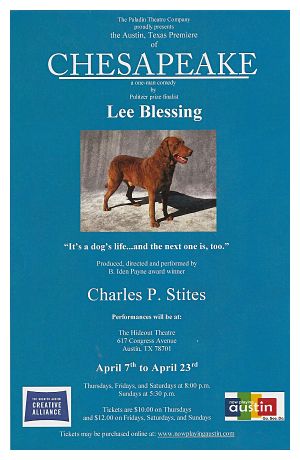Review: Chesapeake by Paladin Theatre Company
by Michael Meigs
Sometimes the miracle happens.
Theatre is a collusion between actors and the audiences: You pretend to be somebody and I'll pretend to believe you. In the subtitle to his 2010 book-length essay The Necessity of Theatre, UT philosophy professor Paul Woodroof calls it "the art of watching and being watching." Writing for a rationalist public in 1817 Coleridge defended the use of the fantastical in poetry by invoking "that willing suspension of disbelief for the moment, which constitutes poetic faith."
I love the collusion. My suspension is just about as elastic as they come, and I'll watch just about any offering of narrative theatre. In his few short sentences on the back of the program card for Chespeake Charles P. Stites, solo player in this piece and director of himself, precisely captures that feeling: "My will to suspend my disbelief is on a hair trigger. As soon as the lights go down in a theatre, I will immediately go anywhere the actors and playwright want to take me."
And sometimes, so very rarely, a text and a performance so transcend that common transaction that you find yourself living from word to word, from gesture to gesture, in a trance of belief that's almost an out-of-body experience. You see through the actor into a succession of images, shaped by language and unexpected turns of plot and character, to a point that when the experience ends, when the lights fade out and you've finished with your convulsion of applause for this suddenly unfamiliar individual in front of you, you linger in that world of imagination for long minutes. As you make your way out of the theatre, navigate downtown streets, locate your car and drive home, you're still out there, somewhere.
Stites' delivery of Lee Blessing's Chesapeake was the most gripping act of theatre imagination I've ever seen in Austin. Take that with as many grains of salt as you like. I've been assiduously attending narrative theatre events here since mid-2008 when I instituted Austin Live Theatre as a blog, and I've written more than 400 reviews in that time.
 "Chesapeake" refers to the breed of Chesapeake retrievers. There's no secret about the principal twist in this story, summarized in most of the publicity and in the tag on the poster ("It's a dog's life . . . and the next one is, too"). A bisexual performance artist named Kerr hates a politician named Therm Pooley; through a chain of improbable events Kerr dies and winds up reincarnated as the politician's dog, a Chesapeake retriever named Lucky.
"Chesapeake" refers to the breed of Chesapeake retrievers. There's no secret about the principal twist in this story, summarized in most of the publicity and in the tag on the poster ("It's a dog's life . . . and the next one is, too"). A bisexual performance artist named Kerr hates a politician named Therm Pooley; through a chain of improbable events Kerr dies and winds up reincarnated as the politician's dog, a Chesapeake retriever named Lucky.
That summary has all the makings of a classic "shaggy dog story," the type of joke that recounts a lengthy, elaborate, improbable and ultimately pointless or anti-climactic story. But this piece is anything but pointless. As Stites writes in his brief note, "What drew me to this play is the story's invention, its imagination, and the distance it takes you from the place it starts out."
In the first act Stites, as Kerr, relates his own escape from a stifling cultural background, his uncertain success in an unusual piece of performance art in which audience members gradually remove articles of his clothing and leave him, ultimately, naked before them, and Congressman Pooley's public attacks against him in a political campaign that eventually wins Pooley a seat in the U.S. Senate.
Stites is intent, articulate and as nakedly confessional in this narrative as his character is in the imagined performance piece, vulnerable and infuriated by turns. He mimics the heavy, cough-syrupy accent of the hated senator, the snippy derision of the Senator's female aide and keeper, and the haughty tone of the Senator's estranged wife. Kerr hatches a revenge plot involving the kidnapping of Lucky, the Chesapeake retriever used by the political gang to brand Pooley with the voters as a benevolent man of the people. The final image of the act, still vivid in my mind, is a long, despairing fall of man and dog together from the lip of a dam into a dry basin below, killing them both.
Act II brings Kerr to the gradual realization that he has awakened within the body of a Chesapeake retriever -- not Lucky, but another from the same litter, brought in as Lucky II to conceal the dog-napping and death of the Senator's symbol. Blessing's text has great ingenuity and detail in evoking the world as perceived and sensed by that canine. The impossible story does the improbable -- exploring new sensations and gradually building a new picture of the politician and his entourage, Stites and Blessing convert our own loyalties. Contempt for a pig-eyed, mean-hearted politician is counter-dosed in gradual, almost homeopathic amounts by anecdote and interplay between Kerr-as-Lucky and his master. Senator Therm Pooley as master of the world becomes for us the prisoner and ultimately the victim of his own career and entourage. Within the persona of Lucky II, Kerr manages to communicate with Pooley, who is frightened and then humbled; the senator approaches the apostasy of advocating in open Senate session an increase in funding for the National Endowment for the Arts.
Each time we think we understand where this story is heading, Stites and Blessing surprise us, winding up eventually with a harrowing climax on the waters of Chesapeake Bay, with trials of will, strength and loyalty.
Charles Stites directed himself in this piece. That seems in itself an act of bravery, perhaps even of foolhardiness, given the richness of the language and story. He has portrayed manipulative egotists in the past -- Mamet characters in Glen Garry, Glen Ross and Sexual Perversity in Chicago, as well as the title role in Tartuffe -- but his Kerr in this piece had none of that arrogance. Using no props other than a straight chair and a couple of bottles of Ozarka spring water, Stites filled up the blankness of the wide ground floor space at the Hideout Theatre with emotion and beautifully controlled movement, both physical and spiritual. The only bombast here was the hollow bombast of Senator Therm Pooley in Act I.
Word must have gotten around. I don't know yet if it was word of mouth or comments from a written review, since I make a practice of never reading other reviewers' comments before writing my own. The house was relatively sparse on Friday night of the third, concluding weekend at the Hideout, but among those in the audience were Martin Burke, Meredith McCall and Trey Deason, and probably other artists, active practitioners and aficionados of Austin's dramatic arts.
This week I'm drawing up the Austin Live Theatre annual list of Applause for theatre arts accomplishments for the year since May 1, 2010. Charles P. Stites is already written in -- both for the categories of director and for male performer in a drama, on the haunting strength and beauty of this Chesapeake.
Review by Ryan E. Johnson at examiner.com, April 12
Review by Barry Pineo for Austin Chronicle, April 21
Review by webmaster, TheatreAustin, Yahoo groups, April 23
EXTRA
Click to view program card for Chesapeake by the Palidin Theatre Company
Hits as of 2015 03 01: 3956
Chesapeake
by Lee Blessing
Paladin Theatre Company
